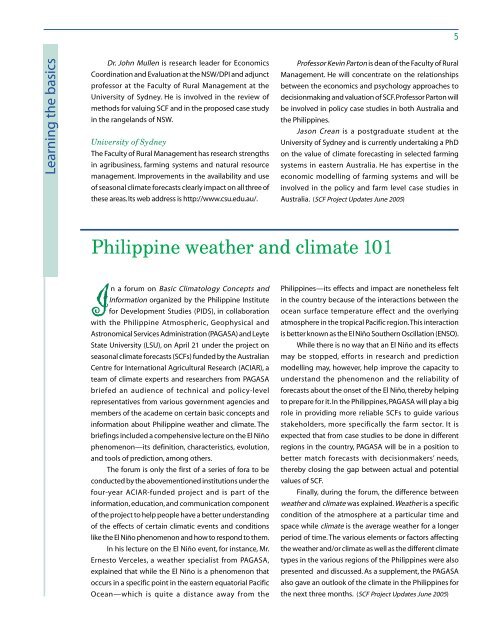Read More - Philippine Institute for Development Studies
Read More - Philippine Institute for Development Studies
Read More - Philippine Institute for Development Studies
You also want an ePaper? Increase the reach of your titles
YUMPU automatically turns print PDFs into web optimized ePapers that Google loves.
5<br />
Learning the basics<br />
Dr. John Mullen is research leader <strong>for</strong> Economics<br />
Coordination and Evaluation at the NSW/DPI and adjunct<br />
professor at the Faculty of Rural Management at the<br />
University of Sydney. He is involved in the review of<br />
methods <strong>for</strong> valuing SCF and in the proposed case study<br />
in the rangelands of NSW.<br />
University of Sydney<br />
The Faculty of Rural Management has research strengths<br />
in agribusiness, farming systems and natural resource<br />
management. Improvements in the availability and use<br />
of seasonal climate <strong>for</strong>ecasts clearly impact on all three of<br />
these areas. Its web address is http://www.csu.edu.au/.<br />
Professor Kevin Parton is dean of the Faculty of Rural<br />
Management. He will concentrate on the relationships<br />
between the economics and psychology approaches to<br />
decisionmaking and valuation of SCF. Professor Parton will<br />
be involved in policy case studies in both Australia and<br />
the <strong>Philippine</strong>s.<br />
Jason Crean is a postgraduate student at the<br />
University of Sydney and is currently undertaking a PhD<br />
on the value of climate <strong>for</strong>ecasting in selected farming<br />
systems in eastern Australia. He has expertise in the<br />
economic modelling of farming systems and will be<br />
involved in the policy and farm level case studies in<br />
Australia. (SCF Project Updates June 2005)<br />
<strong>Philippine</strong> weather and climate 101<br />
In a <strong>for</strong>um on Basic Climatology Concepts and<br />
In<strong>for</strong>mation organized by the <strong>Philippine</strong> <strong>Institute</strong><br />
<strong>for</strong> <strong>Development</strong> <strong>Studies</strong> (PIDS), in collaboration<br />
with the <strong>Philippine</strong> Atmospheric, Geophysical and<br />
Astronomical Services Administration (PAGASA) and Leyte<br />
State University (LSU), on April 21 under the project on<br />
seasonal climate <strong>for</strong>ecasts (SCFs) funded by the Australian<br />
Centre <strong>for</strong> International Agricultural Research (ACIAR), a<br />
team of climate experts and researchers from PAGASA<br />
briefed an audience of technical and policy-level<br />
representatives from various government agencies and<br />
members of the academe on certain basic concepts and<br />
in<strong>for</strong>mation about <strong>Philippine</strong> weather and climate. The<br />
briefings included a compehensive lecture on the El Niño<br />
phenomenon—its definition, characteristics, evolution,<br />
and tools of prediction, among others.<br />
The <strong>for</strong>um is only the first of a series of <strong>for</strong>a to be<br />
conducted by the abovementioned institutions under the<br />
four-year ACIAR-funded project and is part of the<br />
in<strong>for</strong>mation, education, and communication component<br />
of the project to help people have a better understanding<br />
of the effects of certain climatic events and conditions<br />
like the El Niño phenomenon and how to respond to them.<br />
In his lecture on the El Niño event, <strong>for</strong> instance, Mr.<br />
Ernesto Verceles, a weather specialist from PAGASA,<br />
explained that while the El Niño is a phenomenon that<br />
occurs in a specific point in the eastern equatorial Pacific<br />
Ocean—which is quite a distance away from the<br />
<strong>Philippine</strong>s—its effects and impact are nonetheless felt<br />
in the country because of the interactions between the<br />
ocean surface temperature effect and the overlying<br />
atmosphere in the tropical Pacific region. This interaction<br />
is better known as the El Niño Southern Oscillation (ENSO).<br />
While there is no way that an El Niño and its effects<br />
may be stopped, ef<strong>for</strong>ts in research and prediction<br />
modelling may, however, help improve the capacity to<br />
understand the phenomenon and the reliability of<br />
<strong>for</strong>ecasts about the onset of the El Niño, thereby helping<br />
to prepare <strong>for</strong> it. In the <strong>Philippine</strong>s, PAGASA will play a big<br />
role in providing more reliable SCFs to guide various<br />
stakeholders, more specifically the farm sector. It is<br />
expected that from case studies to be done in different<br />
regions in the country, PAGASA will be in a position to<br />
better match <strong>for</strong>ecasts with decisionmakers’ needs,<br />
thereby closing the gap between actual and potential<br />
values of SCF.<br />
Finally, during the <strong>for</strong>um, the difference between<br />
weather and climate was explained. Weather is a specific<br />
condition of the atmosphere at a particular time and<br />
space while climate is the average weather <strong>for</strong> a longer<br />
period of time. The various elements or factors affecting<br />
the weather and/or climate as well as the different climate<br />
types in the various regions of the <strong>Philippine</strong>s were also<br />
presented and discussed. As a supplement, the PAGASA<br />
also gave an outlook of the climate in the <strong>Philippine</strong>s <strong>for</strong><br />
the next three months. (SCF Project Updates June 2005)










